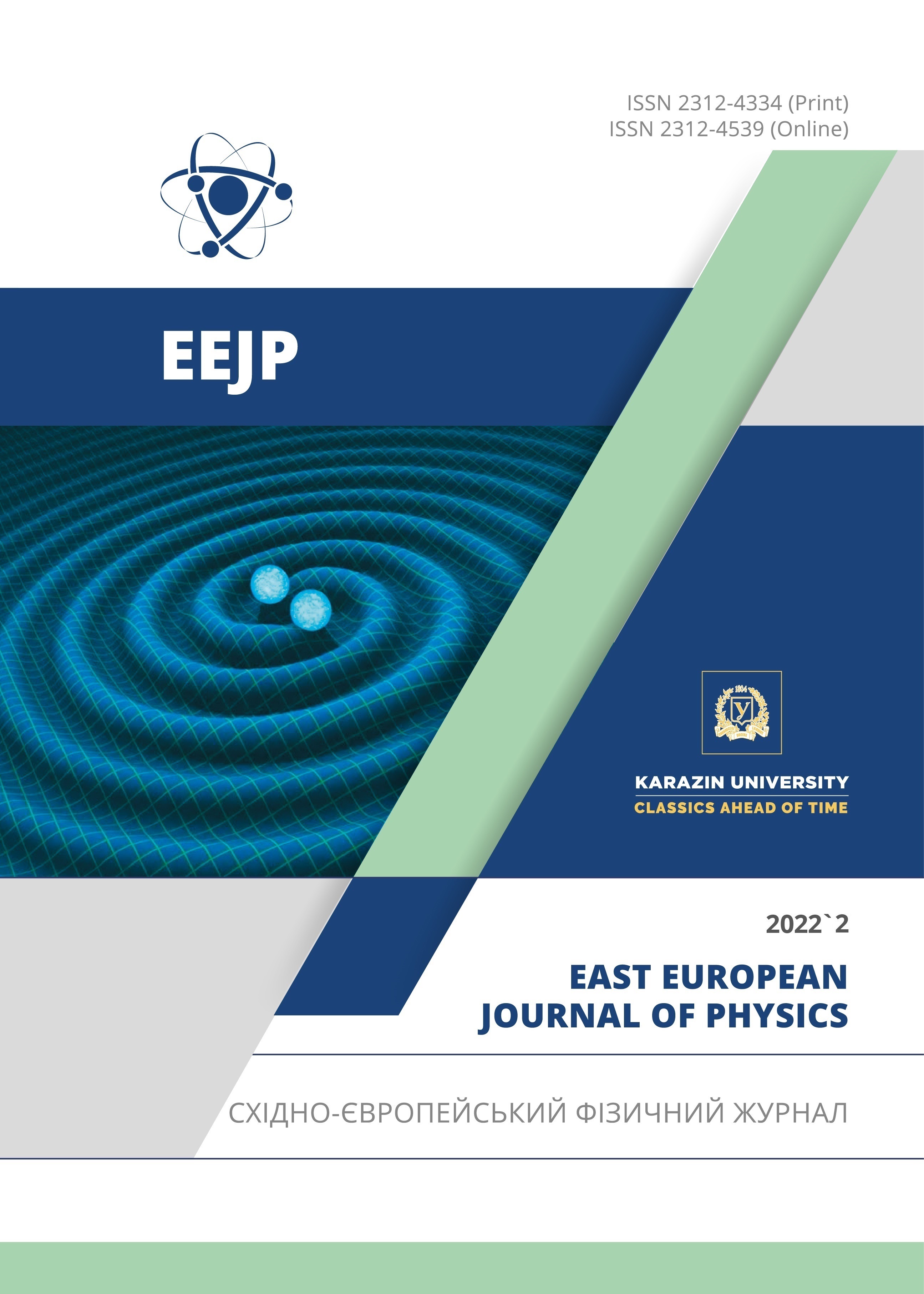Study of Electrical Properties of Nano TiO2 Coatings Based on the Characteristic Matrix Theory and the Brus Model
Abstract
Electrical properties of Nano TiO2 coatings as a function of the nanoparticle size have been studied. In addition, this study explores how to calculate the quantum confinement energy of TiO2. The results confirm the effect of particle size on electrical properties especially when the size becomes close to the exciton Bohr radius. The electrical properties are not effected when the size becomes close to 40 nm. The Bohr radius of Nano TiO2 coatings has been found to be 1.4 nm. While the confinement energy was 0.43 eV. The program depends on the Characteristic Matrix Theory and The Brus Model.
Downloads
References
U. Woggon, Optical Properties of Semiconductor Quantum Dots, (Springer-Verlag Berlin Heidelberg, Germany, 1997).
N.N. Greenwood, and A. Earnshaw, Chemistry of the elements, (Butterworth-Heinemann, Oxford, 1997).
A.A. Al-Khafaji, Ph.D. Thesis. Photocatalysis of Sol-Gel Derived TiO2 for Anti-Dust Properties, University of Baghdad, 2013.
P. Baumeister, Optical Coating Technology, (SPIE Press, 2004).
A. Wisitsoraat, A. Tuantranont, E. Comini, G. Sberveglieri, and W. Wlodarski, “Characterization of n-type and p-type semiconductor gas sensors based on NiOx doped TiO2 thin films, Thin Solid Films”, 517(8), 2775 (2009). https://doi.org/10.1016/j.tsf.2008.10.090
F. Schmidt-Stein, R. Hahn, J.F. Gnichwitz, Y.Y. Song, N.K. Shrestha, A. Hirsch, and P. Schmuki, “X-ray induced photocatalysis on TiO2 and TiO2 nanotubes: Degradation of organics and drug release”, Electrochem. Commun. 11, 2077 (2009), http://dx.doi.org/10.1016/j.elecom.2009.08.036
K. Karki, K.I. Gnanasekar, and B. Rambabu "Nanostructure Semiconductor Oxide Powders and Thin Films for Gas Sensors" Appl. Sur. Sci. 399, 193 (2006), https://www.electrochem.org/dl/ma/202/pdfs/0025.pdf
C. Burda, X. Chen, R. Narayanan, and M.A. El-Sayed, “Chemistry and properties of nanocrystals of different shapes”, Chemical reviews, 105(4), 1025 (2005), https://doi.org/10.1021/cr030063a
L.E. Brus, “Electron-Electron and Electron-Hole Interactions in Small Semiconductor Crystallites: The Size Dependence of the Lowest Excited Electronic State”, Journal of Chemical Physics, 80(9), 4403 (1984), https://doi.org/10.1063/1.447218
Z.L. Wang, Y. Liu, and Z. Zhang, editors, Handbook of nanophase and nanostructured materials, Volume II (Kluwer Academic/Plenum Publishers, Tsinghua University Press, 2003), pp. 428.
B. Bhattacharjee, D. Ganguli, K. Iakoubovskii, A. Stesmans, and S. Chaudhuri, “Synthesis and characterization of sol-gel derived ZnS: Mn2+ nanocrystallites embedded in a silica matrix”, Indian Academy of Sciences, 25(3), 175 (2002). https://doi.org/10.1007/BF02711150
H.A. Macleod, Thin-Film Optical Filters, Fourth Edition, ISBN: 9781420073027, (CRC Press, Taylor & Francis Group, LLC, 2010), pp. 772.
N.M. Ahmed, Design and experimental studies of Multilayer Coatings for Applications in Gallium nitride Emitting Devices, Ph.D. Thesis, University Sa ins Malaysia, 2006(
S.M. Abed, and S.N.T. Al-Rashid, “Designing High reflectivity Omnidirectional coating of Mirrors for Near Infrared Spectrum (700-2500nm)”, Applied physics Research, 5(1), 102 (2013), https://doi.org/10.5539/apr.v5n1p102
A. Scaff, “Introduction to Nanotechnology (Science, Engineering & Applications)” Series of Strategic and Advanced Techniques, Arabic Compendium of Translation, INSB: 139789953824437, (2011).
G. Cao, and Y. Wang, Nanostructures and Nanomaterials: Synthesis, Properties, and Applications, ISBN: 9781783260881, (Imperial College Press, 2004), https://doi.org/10.1142/7885
T. Edvinsson, “Optical quantum confinement and photocatalytic properties in two-, one- and zero- dimensional nanostructures”, Royal Society Open Science, 5(9), 180387 (2018), https://doi.org/10.1098/rsos.180387
Z.L. Wang, Y. Liu, and Z. Zhang, editors, Handbook of nanophase and nanostructured materials, Volume II, ISBN: 9780306472497 (Kluwer Academic Plenum, 2003), pp. 406.
P. Parameshwari, B. Shashidhara, and K. Gopalakrishna, “Structural Electrical and Optical Studies on Spray Deposited Cadmium Sulphide and Copper Indium Disulphide thin films”, Arch. of Physics Research, 3, 441 (2012). https://www.researchgate.net/publication/281333311_Structural_electrical_and_optical_studies_on_spray_deposited_cadmium_sulphide_and_copper_indium_disulphide_thin_film
R. Zallen, The physics of amorphous solids, (Wiley, New York, 1983), pp. 297.
S.X. Xue, S.H. Liu, W. Zhang, J. Wang, L. Tang, B. Shen, and J.W. Zhai, “Dielectric properties and charge-discharge behaviors in niobate glass ceramics for energy-storage applications,” J. Alloys Compd. 617, 418 (2014) https://doi.org/10.1016/j.jallcom.2016.06.024
G.R. Patel, and T.C. Pandya, “Effect of size and shape on static Refractive Index, Dielectric constant and Band gap of Nano solids”, Physics and Applied Sciences, 6(1), 37-42 (2018), https://doi.org/10.26438/ijsrpas/v6i1.3742
Copyright (c) 2022 Sarah A. Hijab, Saeed N. Turki Al-Rashid

This work is licensed under a Creative Commons Attribution 4.0 International License.
Authors who publish with this journal agree to the following terms:
- Authors retain copyright and grant the journal right of first publication with the work simultaneously licensed under a Creative Commons Attribution License that allows others to share the work with an acknowledgment of the work's authorship and initial publication in this journal.
- Authors are able to enter into separate, additional contractual arrangements for the non-exclusive distribution of the journal's published version of the work (e.g., post it to an institutional repository or publish it in a book), with an acknowledgment of its initial publication in this journal.
- Authors are permitted and encouraged to post their work online (e.g., in institutional repositories or on their website) prior to and during the submission process, as it can lead to productive exchanges, as well as earlier and greater citation of published work (See The Effect of Open Access).








